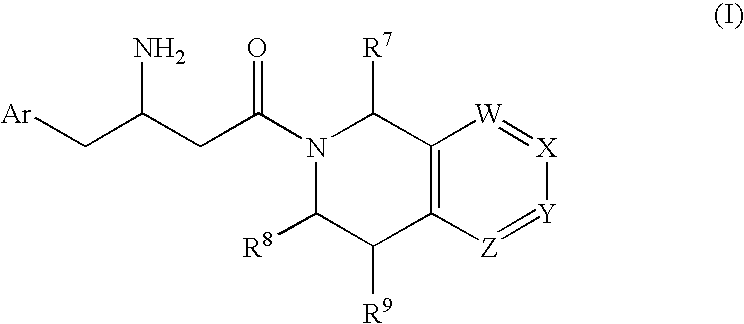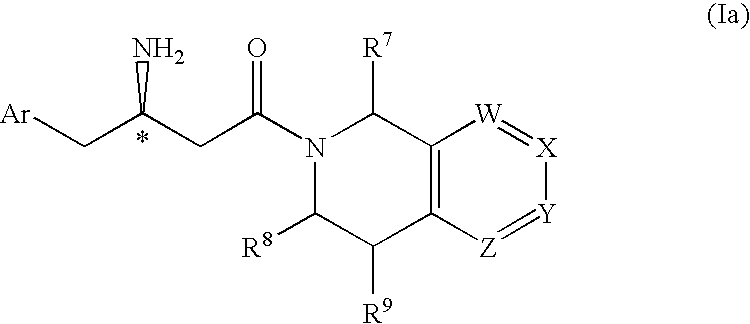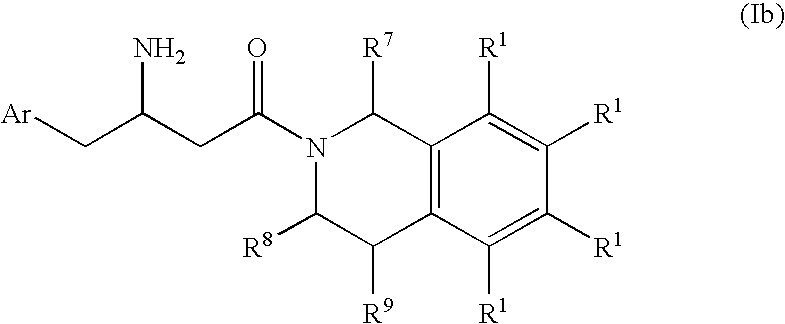3-amino-4-phenylbutanoic acid derivatives as dipeptidyl peptidase inhibitors for the treatment or prevention of diabetes
a technology of dipeptide inhibitors and phenylbutanoic acid, which is applied in the direction of biocide, drug composition, metabolic disorder, etc., can solve the problems of increased and premature morbidity and mortality, increased risk of macrovascular and microvascular complications in patients with type 2 diabetes mellitus, and increased risk of macrovascular and microvascular complications in patients
- Summary
- Abstract
- Description
- Claims
- Application Information
AI Technical Summary
Benefits of technology
Problems solved by technology
Method used
Image
Examples
example 1
[0465]
[4-[[[[(3S)-2-[(3R)-3-Amino-4-(2-fluorophenyl)butanoyl]-1,2,3,4-tetrahydroisoguinolin-3-yl]carbonyl]amino]methyl]phenyl]acetic acid trifluoroacetic acid salt
Step A: Methyl [4-[[[[(3S)-2-[(3R)-3-[(tert-butoxycarbonyl)amino]-4-(2-fluorophenyl)butanoyl]-1,2,3,4-tetrahydroisoguinolin-3-yl]carbonyl]amino]methyl]phenyl]acetate
[0466]A mixture of methyl [4-[[[(3S)-1,2,3,4-tetrahydroisoquinolin-3-ylcarbonyl]amino]methyl]phenyl]acetate trifluoroacetic acid salt (Intermediate 16, 45 mg, 0.10 mmol), commercially available (3R)-3-[(tert-butoxycarbonyl)amino]4-(2-fluorophenyl)butanoic acid (42 mg, 0.14 mmol), 1-(3-(dimethylamino)propyl]-3-ethylcarbodiimide hydrochloride (EDC; 29 mg, 0.15 mmol), 1-hydroxybenzotriazole (HOBt; 20 mg, 0.15 mmol) and N,N-diisopropylethylamine (0.052 mL, 0.30 mmol) in 1.0 mL of dichloromethane was stirred at room temperature for 2 h. The reaction mixture was subjected directly to flash chromatography (silica gel; 60% ethyl acetate / hexanes as eluant) to afford the...
example 2
[0469]
N-[2-[(3R)-3-Amino-4-(2-fluorophenyl)butanoyl]-1,2,3,4-tetrahydroisoguinolin-7-yl]benzenesulfonamide, trifluoroacetic acid salt
Step A: 2-[(3R)-3-[(tert-Butoxycarbonyl)amino]-4-(2-fluorophenyl)butanoyl]-7-nitro-1,2,3,4-tetrahydroisoquinoline
[0470](3R)-3-[(tert-Butoxycarbonyl)amino]4-(2-fluorophenyl)butanoic acid (0.69 g; 2.34 mmol) and 7-nitro-1,2,3,4 tetrahydroisoquinoline (0.50 g; 2.34 mmol) were treated with EDC (0.54 g, 2.8 mmol), HOBt (0.38 g, 2.8 mmol) and N,N-diisopropylethylamine (0.60 g, 4.67 mmol) essentially following the procedure outlined in Example 1, Step A. Purification by flash chromatography (silica gel; 35% ethyl acetate / hexanes as eluant) afforded the title compound. LC / MS: 358.1 (M+1-BOC)
Step B: 7-Amino-2-[(3R)-3-[(tert-butoxycarbonyl)amino]-4-(2-fluorophenyl)butanoyl]-1,2,3,4-tetrahydroisoquinoline
[0471]To the product (0.43 g) from Step A above in 4 mL of methanol was added 20% palladium hydroxide on carbon (Pearlman's catalyst, 0.04 g). The reaction was p...
example 3
[0474]
7-[(3R)-3-Amino-4-(2,5-difluorophenyl)butanoyl]-2-(trifluoromethyl)-5-6,7,8-tetrahydro-1,7-naphthyridine-3-carboxylic acid, trifluoroacetic acid salt
Step A: Ethyl 7-[(3R)-3-[(tert-butoxycarbonyl)amino]-4-(2,5-difluorophenyl)butanoyl]-2-(trifluoromethyl)-5,6,7,8-tetrahydro-1,7-naphthyridine-3-carboxylate
[0475](3R)-3-[(tert-Butoxycarbonyl)amino]-4-(2,5-difluorophenyl)butanoic acid (intermediate 1) and ethyl 2-(trifluoromethyl)-5,6,7,8-tetrahydro-1,7-naphthyridine-3-carboxylate hydrochloride (intermediate 27) were treated with EDC, HOBt and N,N-diisopropylethylamine according to the procedure described for Example 1, Step A to afford the title compound as a white foam.
Step B: 7-[(3R)-3-[(tert-Butoxycarbonyl)amino]-4-(2,5-difluorophenyl)butanoyl]-2-(trifluoromethyl)-5,6,7,8-tetrahydro-1,7-naphthyridine-3-carboxylic acid
[0476]A solution of the product from Step A above (92 mg, 0.161 mmol) in 1.2 mL of 3:2:1 tetrahydrofuran / methanol / water was treated with lithium hydroxide monohydra...
PUM
| Property | Measurement | Unit |
|---|---|---|
| volume | aaaaa | aaaaa |
| emission wavelength | aaaaa | aaaaa |
| excitation wavelength | aaaaa | aaaaa |
Abstract
Description
Claims
Application Information
 Login to View More
Login to View More - R&D
- Intellectual Property
- Life Sciences
- Materials
- Tech Scout
- Unparalleled Data Quality
- Higher Quality Content
- 60% Fewer Hallucinations
Browse by: Latest US Patents, China's latest patents, Technical Efficacy Thesaurus, Application Domain, Technology Topic, Popular Technical Reports.
© 2025 PatSnap. All rights reserved.Legal|Privacy policy|Modern Slavery Act Transparency Statement|Sitemap|About US| Contact US: help@patsnap.com



